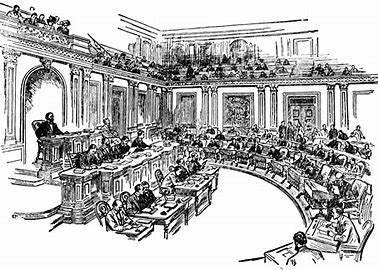US HOUSE PARTICULARS
Chart Interpretation
How to read the US House chart?
Staff: 18 Fulltime and 4 Parttime per Representative
40 x 18FT = 720 @ est. $50Kpy = $36.0Mpy ( + benefits, in-place costs and other expenses)
40 x 4 PT = 160 @ est. $25Kpy = $4.0Mpy ( + benefits, in-place costs and other expenses)
Total $46.960 Mpy ( + benefits, in-place costs, and other expenses)
The purpose of the chart is to show which districts can be combined because of low voter turnout. If we organize districts into area with 700K voting citizens, over 9% of current US House Districts could be dissolved and combined with other districts.
Columns A - E came from a CNN website about the 2024 elections.
Columns F -G are my additions.
I reviewed different population demographic websites and estimate a minor-population of 22%, average across the US. This means 167K persons not-age-eligible to vote in each district,
which brings the possible vote to 594K.
So, there is a jagged edge in my numbers, caused by population counts v. adult voter counts.
Let me give an example of how to read the chart:
Let us pretend there is a State called Euphoria, split off from California.
It has 15 legislative districts. A lot of the seats are held by Independents.
A B C D / E F G
EP-8 Stifle Ind 168/223 29% 8,9
EP-9 Robinson Ind 173/244 32% *
EP-9 Robinson Ind 173/244 32% *
A= US House District number
B= Name of seat-holder
C= Political affiliation
D= 1,000s of votes garnered by winner
E= Total 1,000s of votes cast
F= total vote % of total 761K population
G= which seats can be combined
* = a seat being combined with another district.
? = I don't know how to interpret the given data.
In Euphoria - US House District 8, Independent, Stifle holds the seat, gaining 168K of 223K votes cast. A total of 29% of the district voted. With a total vote of less than 40%, this district is eligible for reassessment, to be combined with another sub-par voting district.
Euphoria - US House District 9, Independent, Robinson holds the seat, gaining 173K of 244K votes cast. A total of 32% of the district voted. With a total vote of less than 40%, this district is eligible
for reassessment, to be combined with another sub-voting district.
(40% of District population, deducting the minors, is about 50% of adults of a 761K District.)
Euphoria Districts 8 and 9 are eligible to be combined because:
> they each have less than 40% voter turnout -
> are next door to each other -
> and have similar political loyalties.
Now, here are the numbers from this reassessment project:
40 House seats dropped: 30-D, 10-R = 9.1%
Salary analysis: ($174Kpy = $174,000 per year)
Elected seats: 40 x $174Kpy = $6.96M (+ benefits, in-place costs and other expenses)
Salary analysis: ($174Kpy = $174,000 per year)
Elected seats: 40 x $174Kpy = $6.96M (+ benefits, in-place costs and other expenses)
Staff: 18 Fulltime and 4 Parttime per Representative
40 x 18FT = 720 @ est. $50Kpy = $36.0Mpy ( + benefits, in-place costs and other expenses)
40 x 4 PT = 160 @ est. $25Kpy = $4.0Mpy ( + benefits, in-place costs and other expenses)
Total $46.960 Mpy ( + benefits, in-place costs, and other expenses)
Each seat in the House generates immediate expenses of over $1,000,000 per year.
More below, about Merit Pay for Congress.


US HOUSE PARTICULARS
Merit Pay for Congress.
Here is what I wish for US Congress:
1) Each state would be responsible to pay the salaries their Congressional representatives.
2) No government-paid retirement pensions for any elected official at any level.
3) No new investing allowed while holding office, except in family projects.
4) 4-year US House terms, 12-year total Federal election service, in either or both Chambers.
5) Merit -based salary. After a base salary of $25K, in both chambers of Congress,
salary would be tied the high school graduation rates in their district, voter turn-out,
and attendance record.
Let's force members of Congress to share the angst of being an adult without a HS diploma.
'Influencers' should be in Middle School assemblies, pushing students toward staying in school through high school graduation, not just speaking at college graduations, wearing fancy robes,
where just a few of that District's survivors shine.
6) Leadership roles in both chambers of Congress be restricted to the Districts
with the top 10% of voter turnout. How can someone lead their chamber into new
legislative endeavors if they can't get their own citizens to the voting booth, eh?
7) In both chambers - elected officials, in Districts with less than 60% voter turnout,
the bottom 10% of either chamber - cannot run for reelection.
If they are indeed powerful influencers in their district, they should be able to get people
into the voting booth. If they can't do that, how are they real influencers?
More below, about low voter turnout.
CHART INTERPRETATION
Why so few voters in minority Districts?
Imagine this:
You are a young black person in a minority-dense Democrat neighborhood.
All the people who run for office in your District - they advocate abortion.
You somehow survived the womb, perhaps grew up fatherless,
and now - you are old enough to vote.
The election cycle begins, the yard signs go up,
and somebody in your neighborhood wants to register you - to vote.
And of course, they expect you to register Democrat,
and they expect you to vote for the same candidates that told your mama to cherish abortion.
Those candidates, who once wanted you aborted -
they now want you to see them as friends and trustworthy advocates.
Hmmm.
And some of the people you know will harangue you about your vote.
This is very confusing.
No wonder you still feel like you are on a plantation. Because you are still on a plantation.
When a person isn't allowed a private opinion or a private vote - they are on a plantation.
And when a child has no value - they are on a plantation.
It's just easier to not vote, eh?
I understand. I don't like being bullied either.
Especially by those who are supposed to share my plight.
**********
And I wouldn't be surprised if you also avoid church,
since in Democrat neighborhoods,
politically-compliant pastors are likely to advocate abortion -
sometimes just by advocating for Democrat candidates.

